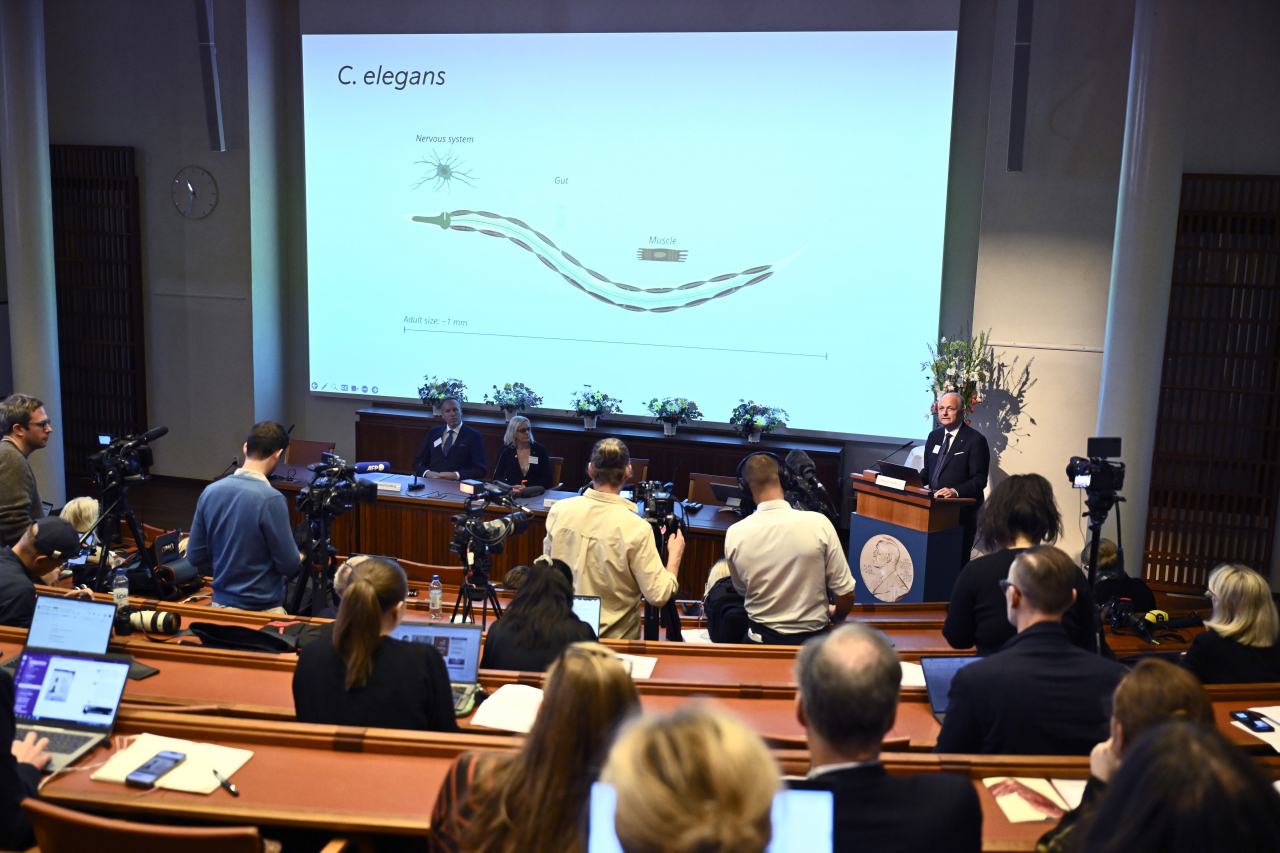
 > World > World News
> World > World News
 |
| Olle Kämpe (right), professor of clinical endocrinology, explains the work of this year's Nobel Prize in Physiology or Medicine laureates Americans Victor Ambros, and Gary Ruvkun during a press conference at the Karolinska Institute in Stockholm, Sweden, on Monday. (AP) |
The Nobel Prize in physiology or medicine was awarded Monday to Americans Victor Ambros and Gary Ruvkun for their discovery of microRNA, tiny pieces of genetic material that alter how genes work at the cellular level and could lead to new ways of treating cancer.
The Nobel Assembly at the Karolinska Institute, which awarded the prize, said the duo's discovery is “proving to be fundamentally important for how organisms develop and function."
“Their groundbreaking discovery revealed a completely new principle of gene regulation that turned out to be essential for multicellular organisms, including humans,” the assembly said in a statement explaining the importance of their work.
Ambros performed the research that led to his prize at Harvard University. He is currently a professor of natural science at the University of Massachusetts Medical School. Ruvkun’s research was performed at Massachusetts General Hospital and the Harvard Medical School, where he’s a professor of genetics, said Thomas Perlmann, Secretary-General of the Nobel Committee.
Perlmann said he spoke to Ruvkun by phone shortly before the announcement.
“It took a long time before he came to the phone and sounded very tired, but he quite rapidly was quite excited and happy, when he understood what it was all about,” Perlmann said.
Ambros and Ruvkun, the assembly explained, were initially interested in genes that control the timing of different genetic developments, ensuring that cell types develop at the right time.
To do that, they studied two mutant strains of worms commonly used as research models in science. The two scientists set out to identify the mutated genes responsible in these worms and what their role was. The mechanism they ultimately identified — the regulation of genes by microRNA — has allowed organisms to evolve for hundreds of millions of years.
The Nobel committee said Ambros and Ruvkun’s discovery ultimately “revealed a new dimension to gene regulation, essential for all complex life forms.”
MicroRNA have opened up scientists’ approaches to treating diseases like cancer by helping to regulate how genes work at the cellular level, according to Dr. Claire Fletcher, a lecturer in molecular oncology at Imperial College London.
Fletcher said microRNA provide genetic instructions to tell cells to make new proteins and that there were two main areas where microRNA could be helpful: in developing drugs to treat diseases and in serving as biomarkers.
“MicroRNA alters how genes in the cell work,” said Fletcher, who is an outside expert not associated with the Nobel prize.
“If we take the example of cancer, we’ll have a particular gene working overtime, it might be mutated and working in overdrive,” she said. “We can take a microRNA that we know alters the activity of that gene and we can deliver that particular microRNA to cancer cells to stop that mutated gene from having its effect.”
Last year, the Nobel Prize in Physiology or Medicine went to Hungarian-American Katalin Karikó and American Drew Weissman for discoveries that enabled the creation of mRNA vaccines against COVID-19 that were critical in slowing the pandemic.
The prize carries a cash award of 11 million Swedish kronor ($1 million) from a bequest left by the prize’s creator, Swedish inventor Alfred Nobel.
The announcement launched this year’s Nobel prizes award season.
Nobel announcements continue with the physics prize on Tuesday, chemistry on Wednesday and literature on Thursday. The Nobel Peace Prize will be announced Friday and the Nobel Memorial Prize in Economic Sciences on Oct. 14.
The laureates are invited to receive their awards at ceremonies on Dec. 10, the anniversary of Nobel’s death.
Fletcher said there are clinical trials ongoing to see how microRNA approaches might help treat skin cancer, but that there aren’t yet any drug treatments approved by drug regulators. She expected that might happen in the next five to 10 years.
She said microRNA represent another way of being able to control the behaviour of genes to treat and track various diseases.
“The majority of therapies we have at the moment are targeting proteins in cells,” she said. “If we can intervene at the microRNA level, it opens up a whole new way of us developing medicines and us controlling the activity of genes whose levels might be altered in diseases.” (AP)








